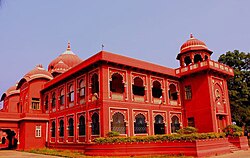Darbhanga district
This article possibly contains original research. (November 2017) |
Darbhanga district | |
|---|---|
District of Bihar | |
 Lalit Narayan Mithila University, Darbhanga | |
 Location of Darbhanga district in Bihar | |
| Country | |
| State | Bihar |
| Division | Darbhanga |
| Headquarters | Darbhanga |
| Government | |
| • Lok Sabha constituencies | Darbhanga |
| • Vidhan Sabha constituencies | Kusheshwar Asthan, Gaura Bauram, Benipur, Alinagar, Darbhanga Rural, Darbhanga, Hayaghat, Bahadurpur, Keoti, Jale |
| Area | |
| • Total | 2,279 km2 (880 sq mi) |
| Population (2011) | |
| • Total | 3,937,385 |
| • Density | 1,700/km2 (4,500/sq mi) |
| • Urban | 8.7 per cent |
| Demographics | |
| • Literacy | 56.56 per cent |
| • Sex ratio | 1024 |
| Time zone | UTC+05:30 (IST) |
| Major highways | NH 27, NH 527B |
| Website | darbhanga |

Darbhanga district is one of the thirty-eight districts of Bihar state in eastern India, and Darbhanga city is the administrative headquarters of this district and 5th largest city of Bihar as well. Darbhanga district is a part of Darbhanga Division. The district is bounded on the north by Madhubani district, on the south by Samastipur district, on the east by Saharsa district and on the west by Sitamarhi and Muzaffarpur districts. The district covers an area of 2,279 km2 (880 sq mi).
History[]
1976 saw the creations of two districts from Darbhanga's territory: Madhubani and Samastipur.[1]
Block and circle[]
- Darbhanga (Vidhan Sabha constituency)
- Baheri (Vidhan Sabha constituency)
- Keoti (Vidhan Sabha constituency)
- Jale (Vidhan Sabha constituency)
- Bahadurpur (Vidhan Sabha constituency)
- Benipur (Vidhan Sabha constituency)
- Manigachhi (Vidhan Sabha constituency)
- Kusheshwar Asthan
- Kusheshwar Asthan Purbi
- Gaura Bauram (Vidhan Sabha constituency)
- Hayaghat (Vidhan Sabha constituency)
- Alinagar (Vidhan Sabha constituency)
- Ghanshyampur (Vidhan Sabha constituency)
Geography[]
Darbhanga district occupies an area of 2,279 square kilometres (880 sq mi),[3] comparatively equivalent to Indonesia's Yapen Island.[4]
Economy[]
In 2006, the Ministry of Panchayati Raj named Darbhanga one of the country's 250 most backward districts (out of a total of 640).[5] It is one of the 36 districts in Bihar currently receiving funds from the Backward Regions Grant Fund Programme (BRGF).[5]
Demographics[]
[6] According to the 2011 census Darbhanga district has a population of 3,937,385[7] roughly equal to the nation of Liberia[8] or the US state of Oregon.[9] This gives it a ranking of 64th in India (out of a total of 640). The district has a population density of 1,721 inhabitants per square kilometre (4,460/sq mi). Its population growth rate over the decade 2001-2011 was 19%.
Population of this district as per 2011 census is 3,985,493 of which rural population is 3,554,057 and urban population is 383,328. According to the Census of India 2011,[10] literacy rate of the district is 56.56%(male 66.83%, female 45.24%).
At the time of the 2011 Census of India, 72.75% of the population in the district spoke Maithili, 20.67% Urdu and 6.51% Hindi as their first language.[11]
| Year | Pop. | ±% p.a. |
|---|---|---|
| 1901 | 889,022 | — |
| 1911 | 894,232 | +0.06% |
| 1921 | 889,302 | −0.06% |
| 1931 | 966,393 | +0.83% |
| 1941 | 1,055,208 | +0.88% |
| 1951 | 1,150,582 | +0.87% |
| 1961 | 1,337,802 | +1.52% |
| 1971 | 1,622,812 | +1.95% |
| 1981 | 2,008,193 | +2.15% |
| 1991 | 2,510,959 | +2.26% |
| 2001 | 3,295,789 | +2.76% |
| 2011 | 3,937,385 | +1.79% |
| source:[7] | ||
See also[]
- Kusheshwar Asthan
- Bahera
- Bathai
- Bauram
- Bhapura
- Chandih
- Chhatwan
- Kumai
- Raj Darbhanga
- Ratanpur
- Supaul Bazar
- Tariyani
References[]
- ^ Law, Gwillim (25 September 2011). "Districts of India". Statoids. Retrieved 11 October 2011.
- ^ https://www.census2011.co.in/data/district/67-darbhanga-bihar.html
- ^ Srivastava, Dayawanti et al. (ed.) (2010). "States and Union Territories: Bihar: Government". India 2010: A Reference Annual (54th ed.). New Delhi, India: Additional Director General, Publications Division, Ministry of Information and Broadcasting (India), Government of India. pp. 1118–1119. ISBN 978-81-230-1617-7.CS1 maint: extra text: authors list (link)
- ^ "Island Directory Tables: Islands by Land Area". United Nations Environment Program. 18 February 1998. Retrieved 11 October 2011.
Yapen 2,278km2
- ^ Jump up to: a b Ministry of Panchayati Raj (8 September 2009). "A Note on the Backward Regions Grant Fund Programme" (PDF). National Institute of Rural Development. Archived from the original (PDF) on 5 April 2012. Retrieved 27 September 2011.
- ^ https://www.census2011.co.in/data/religion/district/67-darbhanga.html
- ^ Jump up to: a b Decadal Variation In Population Since 1901
- ^ US Directorate of Intelligence. "Country Comparison:Population". Retrieved 1 October 2011.
Liberia 3,786,764 July 2011 est.
- ^ "2010 Resident Population Data". U. S. Census Bureau. Archived from the original on 19 October 2013. Retrieved 30 September 2011.
Oregon 3,831,074
- ^ "District-specific Literates and Literacy Rates, 2001". Registrar General, India, Ministry of Home Affairs. Retrieved 5 October 2010.
- ^ 2011 Census of India, Population By Mother Tongue
External links[]
- Darbhanga district
- Populated places in Mithila, India
- Darbhanga division
- Minority Concentrated Districts in India
- Districts of Bihar
